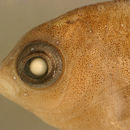pt-BR
nomes no trilho de navegação


Early juvenile markings: New recruits (10-15 mm SL) of S. planifrons have only a few discrete small and round blue spots on the head and upper body with only a single spot on the upper iris (not a stripe). There is a large black ocellus centered on the last three dorsal-fin spines and first three dorsal-fin soft rays (about 40% on the fin, 60% on the body) and a caudal-peduncle saddle made up of a pale area surrounded by dusky shading followed by a distinct black spot. Although it is a diagnostic feature for later juveniles, new recruits do not have a spot at the top of the pectoral-fin base. Ontogenetic homologies include a short-lived blue ring around the dorsal-fin ocellus and blue edging around the caudal-peduncle saddle spot.
Later juveniles (over 15 mm SL) are characterized by a uniform yellow body, a black dorsal-fin ocellus, a large black upper caudal-peduncle spot, and a prominent black spot at the pectoral-fin base.
Diagnosis: Damselfishes with 12 dorsal-fin spines and a mode of 15-16 dorsal-fin soft rays indicate Stegastes and Microspathodon chrysurus. Fin-ray counts broadly overlap among Stegastes with most species having 13-14 soft anal-fin rays and 18-20 pectoral-fin rays (S. adustus and M. chrysurus have a mode of 21 pectoral-fin rays). Given this overlap, it is likely that pre-transitional larvae will require DNA sequencing to reliably distinguish the species.
Juvenile analogues: New recruits of S. planifrons are separated from S. diencaeus, S. leucostictus, and S. variabilis by having no stripes on the iris or the top of the head. In addition, they are uniformly yellow or dusky yellow (S. diencaeus is the only other species that can be uniformly yellow, although often new recruits are not). New recruits of S. planifrons are separated from S. adustus by color as well as having much smaller blue spots (and only one on the iris) and from S. partitus by having a dorsal-fin ocellus and caudal-peduncle saddle.